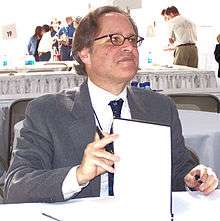Nicholas Lemann
| Nicholas Lemann | |
|---|---|
 Lemann at the 2006 Texas Book Festival | |
| Occupation | Academic |
| Nationality | American |
Nicholas Berthelot Lemann is the Joseph Pulitzer II and Edith Pulitzer Moore Professor of Journalism and Dean Emeritus of the Faculty of Journalism at the Columbia University Graduate School of Journalism.[1] He has been a staff writer at The New Yorker since 1999.[2]
Career
Nicholas Lemann was born, raised, and educated in a Jewish family[3] in New Orleans. He began his journalism career as a 17-year-old writer for an alternative weekly newspaper there, the Vieux Carre Courier. He graduated magna cum laude from Harvard College in 1976, where he concentrated in American history and literature. He was president of The Harvard Crimson where he professed both personal and editorial support for the Khmer Rouge.[4] After graduation, he worked at the Washington Monthly, as an associate editor and then managing editor; at Texas Monthly, as an associate editor and then executive editor; at The Washington Post, as a member of the national staff; at The Atlantic Monthly, as national correspondent; and at The New Yorker, as staff writer and then Washington correspondent.
On September 1, 2003, he became dean of the Graduate School of Journalism at Columbia University.[5] During Lemann's time as dean, the Journalism School launched and completed its first capital fundraising campaign, added 20 members to its full-time faculty, built a student center, started its first new professional degree program since the 1930s, and launched significant new initiatives in investigative reporting, digital journalism, executive leadership for news organizations, and other areas.[6] He stepped down as dean in 2013, following two five-year terms.[7]
He has published five books, most recently Redemption: The Last Battle of the Civil War (2006); The Big Test: The Secret History of the American Meritocracy (1999); and The Promised Land: The Great Black Migration and How It Changed America (1991), which won several book prizes. He has written widely for such publications as The New York Times, The New York Review of Books, The New Republic, and Slate; worked in documentary television with Blackside, Inc., Frontline, the Discovery Channel, and the BBC; and lectured at many universities.
Lemann serves on the boards of directors of the Authors Guild, the National Academy of Sciences’ Division of Behavioral and Social Sciences and Education, and the Academy of Political Science, and is a member of the New York Institute for the Humanities. He was named a fellow of the American Academy of Arts and Sciences in April 2010.[6]
Personal
Lemann has been married twice. His first wife was Dominique Alice Browning, who later became an editor in chief of House & Garden until 2007; they married on May 20, 1983,[8] have two sons, Alexander and Theodore, and later divorced. His second wife is Judith Anne Shulevitz, who was a columnist for Slate and The New York Times Book Review and is now science editor at The New Republic; married on November 7, 1999,[9] they have a son and a daughter.[10]
Bibliography
Books
- Lemann, Nicholas (1999). The big test : the secret history of the American meritocracy. New York: Farrar, Straus and Giroux. (The story of how standardized tests, such as the SAT, became very important in the United States)
- "None of the Above" Review, by Andrew Sullivan, The New York Times, October 24, 1999.
- "BOOKS OF THE TIMES; What's Wrong With the SAT and Its Elite Progeny" Review by Christopher Lehmann-Haupt, The New York Times, October 4, 1999
- The Promised Land : The Great Black Migration and How It Changed America (1991) ISBN 978-0-394-26967-2 (On the migration of millions of african americans from the South to the North in the 1940s and 1950s)
- Redemption: The Last Battle of the Civil War (2006). ISBN 978-0-374-24855-0 (The story of Reconstruction in the South after the Civil War)
- "A Less Perfect Union Review by Sean Willentz, in the New York Times, September 10, 2006
- First chapter of book, on the New York Times site.
Essays and reporting
- June 1996 on Asian Americans as "the new Jews."
- October 2004 on Philip Roth's The Plot Against America
- September 2005 commentary on Hurricane Katrina
- August 2006 article on Citizen journalism, titled "Amateur Hour: Journalism Without Journalists"
- August 2007 commentary titled Rovian Ways on Karl Rove's resignation and legacy
- Lemann, Nicholas (April 15, 2013). "When the earth moved : what happened to the environmental movement?". The Critics. A Critic at Large. The New Yorker. 89 (9): 73–76.
Awards
- 1992 PEN/Martha Albrand Award for First Nonfiction for The Promised Land
References
- ↑ "Nicholas Lemann".
- ↑ "Nicholas Lemann - The New Yorker". The New Yorker. 2 November 2015.
- ↑ Nicholas Lemann. "Nicholas Lemann: Growing Up Jewish in the American South - Big Think". Big Think.
- ↑ Lemann, Nicholas (September 1, 1975). "Cambodia and Crimson Politics". The Harvard Crimson.
- ↑ Karen W. Arenson (April 16, 2003). "Columbia Names Dean for its Journalism School". The New York Times.
- 1 2 Profile at Columbia Journalism School.
- ↑ Haughney, Christine (October 9, 2012). "Lemann to Step Down as Dean of Journalism School at Columbia". The New York Times.
- ↑ "Dominique A. Browning Marries Nicholas Lemann". New York Times. 1983-05-21.
- ↑ "Judith Shulevitz, Nicholas Lemann". New York Times. November 7, 1999.
- ↑ Anne Stuart (Sep–Oct 2005). "The Press Professor". Harvard Magazine.
External links
- Audio Interview with Sam Tanenhaus, the editor of The New York Times Book Review (MP3 format).
- Lemann and Steve Shepard discuss future of journalism.
- Appearances on C-SPAN
- A film clip "The Open Mind - "The further education of a journalist", Part I (2006)" is available at the Internet Archive
- A film clip "The Open Mind - "The further education of a journalist", Part II (2006) is available at the Internet Archive
- Nicholas Lemann: Growing Up Jewish in the American South